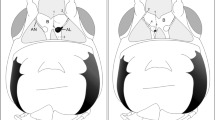Abstract
Beetles of the genus Melanophila are able to detect infrared radiation by using specialized sensilla in their metathoracic pit organs. We describe the afferent projections of the infrared-sensitive neurons in the central nervous system. The axons primarily terminate in the central neuropil of the fused second thoracic ganglia where they establish putative contacts with ascending interneurons. Only a few collaterals appear to be involved in local (uniganglionic) circuits. About half of the neurons send their axons further anterior to the prothoracic ganglion. A subset of these ascend to the subesophageal ganglion, and about 10% project to the brain. Anatomical similarities suggest that the infrared-sensitive neurons are derived from neurons supplying mechanosensory sensilla. The arborization pattern of the infrared afferents suggests that infrared information is processed and integrated upstream from the thoracic ganglia.
Similar content being viewed by others
Author information
Authors and Affiliations
Additional information
Received: 3 December 1998 / Accepted: 25 March 1999
Rights and permissions
About this article
Cite this article
Gronenberg, W., Schmitz, H. Afferent projections of infrared-sensitive sensilla in the beetle Melanophila acuminata (Coleoptera: Buprestidae). Cell Tissue Res 297, 311–318 (1999). https://doi.org/10.1007/s004410051359
Issue Date:
DOI: https://doi.org/10.1007/s004410051359




